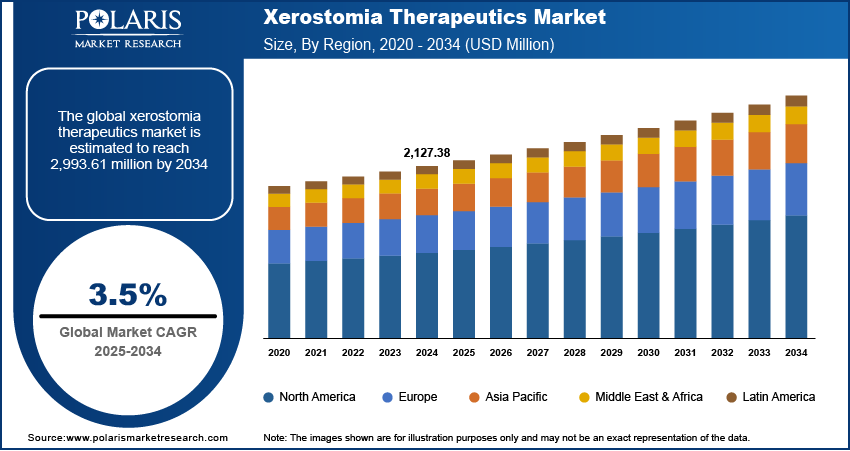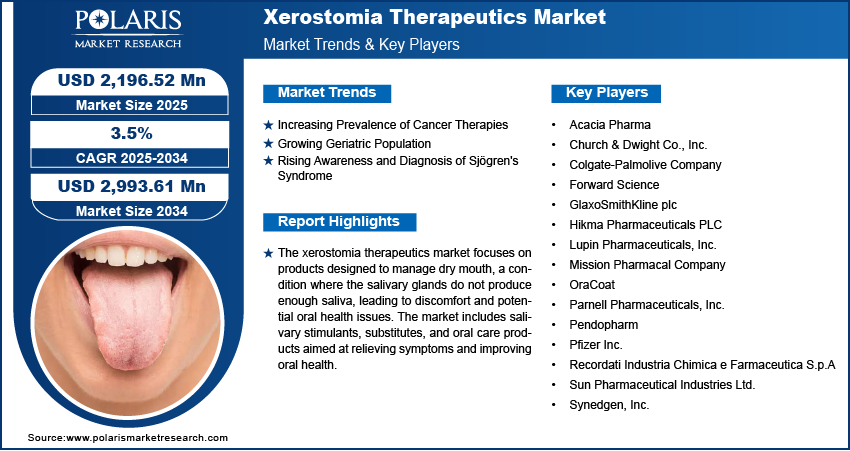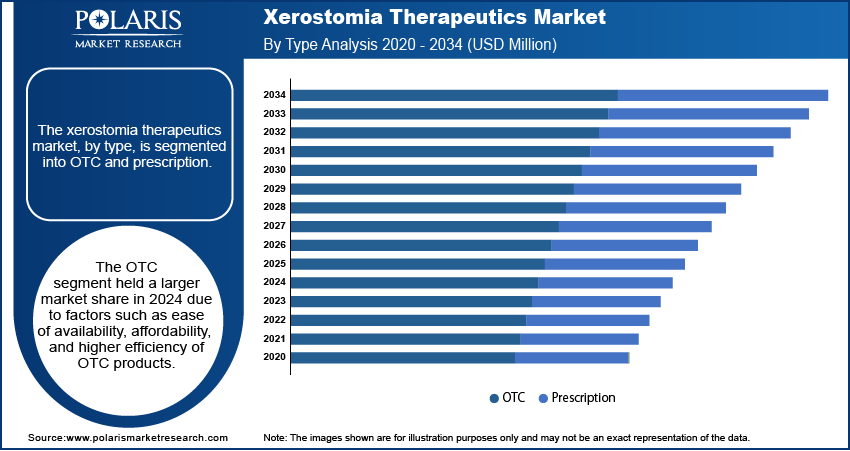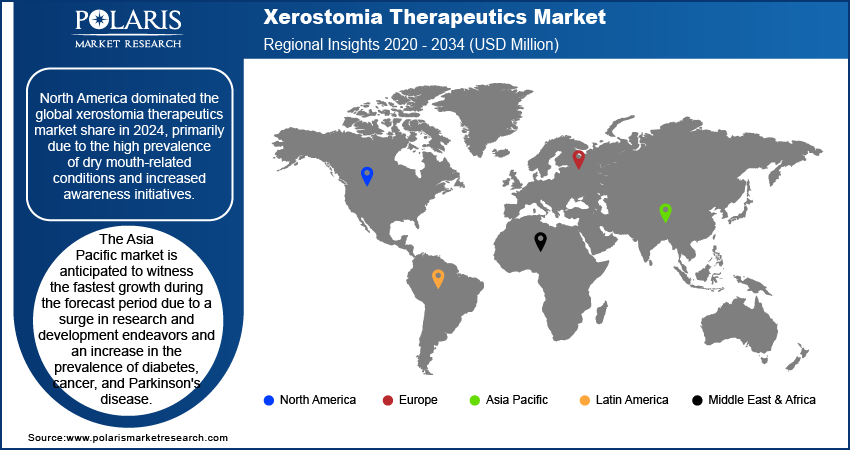
Xerostomia Therapeutics Market Size, Share, Trends, Industry Analysis Report: By Type (OTC and Prescription), Product, and Region (North America, Europe, Asia Pacific, Latin America, and Middle East & Africa) – Market Forecast, 2025–2034
- Published Date:Apr-2025
- Pages: 117
- Format: PDF
- Report ID: PM1339
- Base Year: 2024
- Historical Data: 2020-2023
Xerostomia Therapeutics Market Overview
The xerostomia therapeutics market size was valued at USD 2,127.38 million in 2024. The market is projected to grow from USD 2,196.52 million in 2025 to USD 2,993.61 million by 2034, exhibiting a CAGR of 3.5% during 2025–2034.
The xerostomia therapeutics market focuses on treatments for dry mouth, a condition caused by reduced saliva production due to factors such as medication use, radiation therapy, autoimmune diseases, and aging. The market is driven by the increasing prevalence of chronic diseases, rising geriatric population, and growing awareness of the condition’s impact on oral health. Key xerostomia therapeutics market trends include advancements in saliva substitutes, the development of novel drug formulations, and increased research into regenerative therapies targeting salivary gland function. Additionally, pharmaceutical companies are investing in prescription treatments while over-the-counter product availability continues to expand, driving market growth.

To Understand More About this Research: Request a Free Sample Report
Xerostomia Therapeutics Market Dynamics
Increasing Prevalence of Cancer Therapies
The rising adoption of chemotherapy and radiotherapy in cancer treatment has led to a higher incidence of xerostomia among patients. These therapies often damage salivary glands, resulting in reduced saliva production. This increase in chemotherapy and radiotherapy propels the xerostomia therapeutics market demand.
Growing Geriatric Population
The expanding elderly population contributes significantly to the xerostomia therapeutics market growth. According to the World Health Organization, the global population aged 60 years and above is expected to reach 2 million by 2050, up from 900 million in 2015. Aging is associated with a natural decline in salivary gland function and an increase in the likelihood of chronic diseases. The medications for these chronic diseases may induce dry mouth as a side effect, leading to a high demand for xerostomia therapeutics.
Rising Awareness and Diagnosis of Sjögren's Syndrome
Patients diagnosed with Sjögren's syndrome experience severe dry mouth, which affects their ability to speak, eat, and maintain oral health. Healthcare professionals across the globe are educating patients about this condition, emphasizing the importance of early intervention, thereby boosting demand for xerostomia therapeutics.

Xerostomia Therapeutics Market Segment Insights
Xerostomia Therapeutics Market Assessment by Type
The xerostomia therapeutics market, by type, is segmented into OTC and prescription. The OTC segment dominated the market share in 2024. This dominance is attributed to factors such as ease of availability, affordability, and higher efficiency of OTC products. Patients often prefer OTC solutions for immediate relief from dry mouth symptoms, contributing to the segment's prominence.
The prescription segment is experiencing significant growth, driven by the increasing prevalence of chronic conditions such as Sjögren's syndrome and the side effects of certain medications that cause dry mouth. Healthcare professionals are prescribing targeted therapeutics to manage severe xerostomia cases, leading to a rise in demand within this segment.
Xerostomia Therapeutics Market Evaluation by Product
The xerostomia therapeutics market, by product, is segmented into salivary stimulants, salivary substitutes, and dentifrices. The salivary stimulants segment dominated the xerostomia therapeutics market share in 2024 due to their ability to activate residual salivary gland function, providing relief for patients experiencing dry mouth. Salivary substitutes also play a crucial role in managing xerostomia, particularly for individuals with limited or no salivary gland activity. These products, including artificial saliva formulations, help maintain oral moisture and comfort. The usage of xerostomia therapeutics is essential in comprehensive xerostomia management, especially for patients undergoing treatments that impair salivary function.

Xerostomia Therapeutics Market Regional Outlook
By region, the study provides xerostomia therapeutics market insights into North America, Europe, Asia Pacific, Latin America, and the Middle East & Africa. North America dominated the xerostomia therapeutics market revenue share in 2024, primarily due to the high prevalence of dry mouth-related conditions and increased awareness initiatives. The region's dominance is further supported by a significant number of patients seeking treatment, contributing to market expansion.
In Europe, the xerostomia therapeutics market is experiencing growth due to an increasing geriatric population and high awareness of dry mouth conditions. The rising prevalence of diseases such as Sjögren's syndrome and rheumatoid arthritis contributes to the demand for effective treatments in the region. Additionally, initiatives aimed at raising awareness about dry mouth conditions are supporting xerostomia therapeutics market expansion in the region.
The Asia Pacific xerostomia therapeutics market is anticipated to witness the fastest growth during the forecast period. Factors such as a surge in research and development endeavors, an increase in the prevalence of diabetes, cancer, and Parkinson's treatment, and growing collaborations among market participants are driving this expansion. Japan is expected to register the highest CAGR in the regional market during the forecast period, reflecting the region's significant market potential.

Xerostomia Therapeutics Market – Key Players and Competitive Analysis Reports
The xerostomia therapeutics market comprises several active companies offering various treatments for dry mouth. A few notable participants include GlaxoSmithKline plc, known for its product Biotène; Church & Dwight Co., Inc.; Colgate-Palmolive Company; Hikma Pharmaceuticals PLC; and Pendopharm. These companies provide a range of over-the-counter and prescription products aimed at alleviating xerostomia symptoms.
Other significant contributors to the market are Sun Pharmaceutical Industries Ltd.; Lupin Pharmaceuticals, Inc.; Pfizer Inc.; Parnell Pharmaceuticals, Inc.; and Acacia Pharma. These organizations focus on developing and distributing therapeutic solutions to manage dry mouth conditions, catering to diverse patient needs.
Companies such as OraCoat; Synedgen, Inc.; Recordati Industria Chimica e Farmaceutica S.p.A; Forward Science; and Mission Pharmacal Company are active in this sector. Their involvement enhances the availability of various treatment options, contributing to the overall growth and competitiveness of the xerostomia therapeutics market.
GlaxoSmithKline plc (GSK) is a major British multinational pharmaceutical and biotechnology company headquartered in Brentford, UK. Established in 2000 through the merger of Glaxo Wellcome and SmithKline Beecham, GSK operates globally with research centers in the UK, USA, Belgium, and China. The company specializes in developing and marketing vaccines, pharmaceuticals, consumer healthcare products, and over-the-counter medicines. Its diverse portfolio includes treatments for respiratory diseases, HIV, cancer, cardiovascular conditions, and central nervous system disorders. GSK also offers vaccines for hepatitis A and B, whooping cough, and the world's first malaria vaccine (RTS, S). The company is renowned for its contributions to global health, including several essential medicines listed by the World Health Organization.
Acacia Pharma Group plc, founded in 2006 and headquartered in Cambridge, United Kingdom, is a biopharmaceutical company specializing in supportive care solutions for patients undergoing surgery, invasive procedures, or chemotherapy. The company operates as a subsidiary of Eagle Pharmaceuticals, Inc. Acacia Pharma’s portfolio includes FDA-approved products such as BARHEMSYS, an intravenous amisulpride for the treatment and prevention of postoperative nausea and vomiting (PONV), and BYFAVO, an intravenous remimazolam used for procedural sedation during short medical interventions like colonoscopy. Additionally, the company has developed APD403, a selective dopamine antagonist amisulpride that has completed Phase II trials for chemotherapy-induced nausea and vomiting (CINV). Acacia Pharma’s innovative approach leverages known pharmaceuticals to develop rapid clinical proof-of-concept products tailored to unmet medical needs. Acacia Pharma has also explored xerostomia therapeutics through its product APD515. This treatment targets xerostomia in advanced cancer patients, focusing on improving their quality of life.
List of Key Companies in Xerostomia Therapeutics Market
- Acacia Pharma
- Church & Dwight Co., Inc.
- Colgate-Palmolive Company
- Forward Science
- GlaxoSmithKline plc
- Hikma Pharmaceuticals PLC
- Lupin Pharmaceuticals, Inc.
- Mission Pharmacal Company
- OraCoat
- Parnell Pharmaceuticals, Inc.
- Pendopharm
- Pfizer Inc.
- Recordati Industria Chimica e Farmaceutica S.p.A
- Sun Pharmaceutical Industries Ltd.
- Synedgen, Inc.
Xerostomia Therapeutics Industry Developments
- December 2024: MeiraGTx announced that the FDA had granted Regenerative Medicine Advanced Therapy (RMAT) designation to AAV2-hAQP1 for the treatment of Grade 2/3 radiation-induced xerostomia (RIX).
Xerostomia Therapeutics Market Segmentation
By Type Outlook (Revenue – USD Million, 2020–2034)
- OTC
- Prescription
By Product Outlook (Revenue – USD Million, 2020–2034)
- Salivary Stimulants
- Salivary Substitutes
- Dentifrices
By Regional Outlook (Revenue – USD Million, 2020–2034)
- North America
- US
- Canada
- Europe
- Germany
- France
- UK
- Italy
- Spain
- Netherlands
- Russia
- Rest of Europe
- Asia Pacific
- China
- Japan
- India
- Malaysia
- South Korea
- Indonesia
- Australia
- Vietnam
- Rest of Asia Pacific
- Middle East & Africa
- Saudi Arabia
- UAE
- Israel
- South Africa
- Rest of Middle East & Africa
- Latin America
- Mexico
- Brazil
- Argentina
- Rest of Latin America
Xerostomia Therapeutics Market Report Scope
|
Report Attributes |
Details |
|
Market Size in 2024 |
USD 2,127.38 million |
|
Market Value in 2025 |
USD 2,196.52 million |
|
Revenue Forecast by 2034 |
USD 2,993.61 million |
|
CAGR |
3.5% from 2025 to 2034 |
|
Base Year |
2024 |
|
Historical Data |
2020–2023 |
|
Forecast Period |
2025–2034 |
|
Quantitative Units |
Revenue in USD million and CAGR from 2025 to 2034 |
|
Report Coverage |
Revenue Forecast, Market Competitive Landscape, Growth Factors, and Trends |
|
Segments Covered |
|
|
Regional Scope |
|
|
Competitive Landscape |
|
|
Report Format |
|
|
Customization |
Report customization as per your requirements with respect to countries, regions, and segmentation. |
How is the report valuable for an organization?
Workflow/Innovation Strategy
The xerostomia therapeutics market has been segmented into detailed segments of type and product. Moreover, the study provides the reader with a detailed understanding of the different segments at both the global and regional levels.
Growth/Marketing Strategy
The xerostomia therapeutics market growth and marketing strategy focuses on expanding product offerings and increasing awareness about dry mouth conditions. Companies are investing in research and development to introduce innovative solutions, such as advanced salivary substitutes and stimulants, to address a broader range of patient needs. Collaborative partnerships, especially with healthcare professionals, are being prioritized to improve diagnosis and treatment access. Additionally, companies are leveraging digital platforms for targeted marketing and expanding distribution channels, including online sales and pharmacies, to reach a wider audience. These strategies are aimed at capitalizing on the growing demand driven by an aging population and increasing awareness of xerostomia.
FAQ's
The market size was valued at USD 2,127.38 million in 2024 and is projected to grow to USD 2,993.61 million by 2034.
The market is projected to register a CAGR of 3.5% during 2024–2034.
North America held the largest share of the market in 2024
The market comprises several active companies offering various treatments for dry mouth. A few notable participants include Acacia Pharma; Church & Dwight Co., Inc.; Colgate-Palmolive Company; Forward Science; GlaxoSmithKline plc; Hikma Pharmaceuticals PLC; Lupin Pharmaceuticals, Inc.; Mission Pharmacal Company; OraCoat; Parnell Pharmaceuticals, Inc.; Pendopharm; Pfizer Inc.; Recordati Industria Chimica e Farmaceutica S.p.A; Sun Pharmaceutical Industries Ltd.; and Synedgen, Inc.
The OTC segment accounted for a larger share of the market in 2024.
The salivary stimulants segment accounted for the largest share of the market in 2024.
Xerostomia therapeutics refer to the treatments and products designed to manage and alleviate the symptoms of dry mouth (xerostomia), which occurs when the salivary glands do not produce enough saliva. This condition can be caused by factors such as medication side effects, certain medical conditions (e.g., Sjögren's syndrome), radiation therapy, or aging. Xerostomia therapeutics include over-the-counter products such as saliva substitutes, prescription medications that stimulate saliva production, and oral care products designed to maintain moisture in the mouth. These treatments aim to provide relief from discomfort, prevent oral health issues such as tooth decay and gum disease, and improve the quality of life for individuals suffering from dry mouth.
A few key trends in the market are described below: Advancements in Product Formulations: Development of more effective and long-lasting salivary stimulants and substitutes to improve patient comfort. Increased Focus on Prescription Treatments: Growing demand for prescription drugs that target the root causes of xerostomia, particularly in patients suffering from chronic conditions such as Sjögren's syndrome. Rise in Over-the-Counter Products: Expanding availability of OTC products offers convenience and affordability for individuals seeking quick relief. Use of Digital Platforms: Companies are utilizing e-commerce and digital marketing strategies to reach wider audiences and improve accessibility to treatments.
A new company entering the market must focus on innovation in product development by creating more effective and long-lasting solutions, particularly in prescription treatments that address the underlying causes of dry mouth. Emphasizing personalized treatment options tailored to specific patient needs could differentiate the company in the market. Additionally, leveraging digital platforms for direct-to-consumer sales and awareness campaigns could help reach a wider audience. Establishing strong collaborations with healthcare providers for early diagnosis and treatment guidance could further enhance market positioning. Focusing on emerging markets with rising healthcare demands, such as Asia Pacific, could provide growth opportunities.
Companies manufacturing, distributing, or purchasing xerostomia therapeutics-related products and other consulting firms must buy the report.
